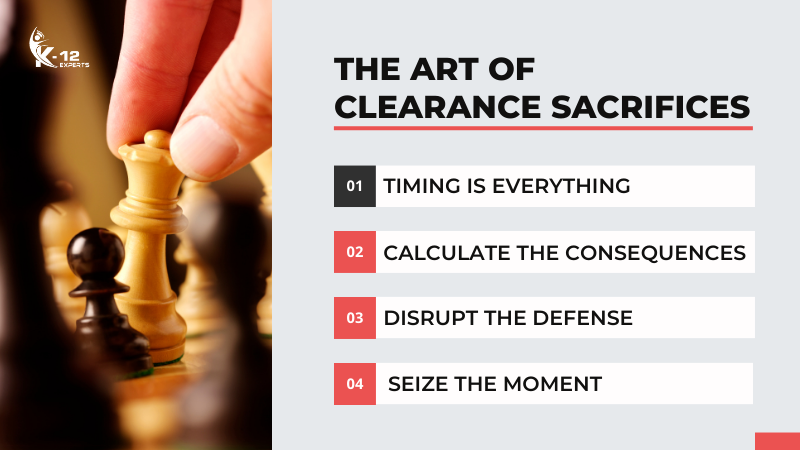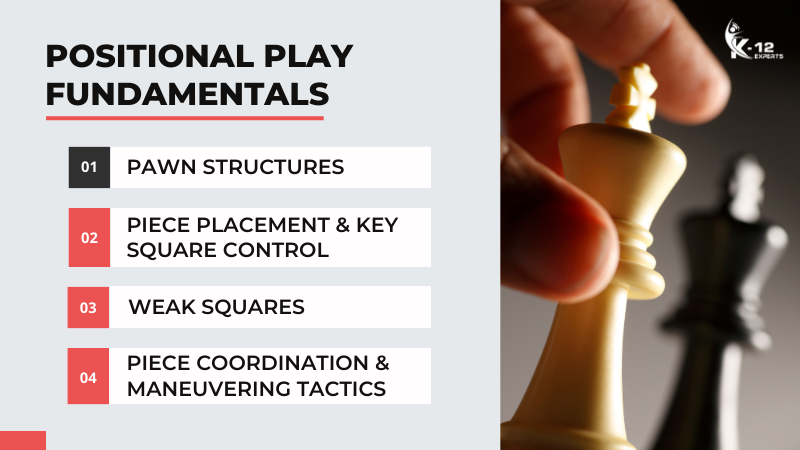Begin a chess adventure where you’re not just maneuvering pieces but mastering the art of the game itself! Envision swapping a knight as if negotiating a castle trade or anticipating that enchanting moment to execute an exchange sacrifice that leaves your opponent scratching their head in confusion. You’ll uncover the sorcery behind clearance and overloading strategies that feel like performing a magic trick and the subtle craftiness of interference plays that disrupt your foe’s well-thought-out plans. Whether you’re navigating through the battlefield with positional play expertise or shining in the endgame, every move brings you closer to triumph.
But the real hidden gem? Promotion – because occasionally, transforming a pawn into a knight instead of a queen isn’t just playful; it’s brilliant. So, if you’ve ever imagined enhancing your game from mere mortal to chess champion, this journey of strategy will guide the path. Now, let’s discover what tactics you can incorporate into your arsenal, shall we?
Mastering Exchange Sacrifices

To master exchange sacrifices, you must understand that you’re trading a piece for a strategic edge, not just material. It’s like swapping your knight for a fortress; chess players often utilize this tactic to outmaneuver their opponents’ pieces, creating imbalances that tilt the board in their favor.
But don’t just hurl your rook at the first sign of trouble. The art lies in timing and precision. Envision you’re a magician, and your exchange sacrifice is a grand illusion that leaves your opponent gasping.
It’s not about losing a piece; it’s about gaining a kingdom. So, immerse yourself in this adventure with a sparkle in your eyes and an ace up your sleeve. Remember, every exchange sacrifice is a story waiting to be told.
The Art of Clearance Sacrifices

After mastering exchange sacrifices, it’s time to explore how clearance sacrifices can elevate your game by clearing the way for a decisive strike. The key here is to try to find the perfect moment for your pieces to shine by making room on the board.
Here’s how:
- Timing is Everything: Wait for the opportune moment when your opponent least expects it.
- Calculate the Consequences: Make sure the juice is worth the squeeze. You’re giving up a piece, after all!
- Disrupt the Defense: Your sacrifice should leave your opponent scratching their head, wondering what hit them.
- Seize the Moment: With the path clear, launch your attack and watch as your opponent’s defenses crumble.
Strategies for Overloading
Identifying your opponent’s overloaded pieces can open the door to tactical victories by forcing them to make tough decisions. You’ll need to weave a web of strategic planning laced with tactical sacrifices and not forget those sneaky defensive maneuvers.
| Strategy | Goal | Outcome |
| Overloading | Create pressure | Tactical win |
| Sacrifices | Gain advantage | Material win |
| Timing | Max impact | Positional advantage |
| Calculation | Precise attack | Opponent’s dilemma |
| Awareness | Exploit defense | Vulnerability exposure |
This chess dance isn’t just about boldly charging in; it’s about being a sly fox, waiting for the perfect moment. By mastering overloading, you’re not just playing chess; you’re orchestrating a symphony of strategic chaos. Who knew outsmarting your opponent could be so devilishly fun?
Utilizing Interference

In chess, leveraging interference involves strategically sacrificing a piece to disrupt your opponent’s coordination and block their defenders from important squares. It’s like throwing a wrench in their plans, creating chaos, and leaving them scratching their heads.
Here’s how to master this art:
- Creating Chaos: Aim to disrupt your opponent with tactical sacrifices. It’s all about the element of surprise.
- Tactical Sacrifices: Use these to gain a pivotal advantage. Think of it as a chess version of a Trojan Horse.
- Strategic Interference: Timing is vital. Wait for the perfect moment to strike, making your move feel like a plot twist in a blockbuster movie.
- Positional Advantage: Look for opportunities that leave your opponent off-balance, ensuring your pieces dominate the board.
The Power of Underpromotion

While most players aim for the queen when promoting a pawn, underpromotion offers a strategic twist that can catch your opponent off guard and turn the tide of the game. Imagine the look on their face when your pawn morphs into a knight, not a queen, delivering a checkmate they never saw coming.
This is where tactical surprises and creative strategies come into play, making underpromotion a tool for those who thrive on unexpected threats and disruptive moves. Strategic underpromotions require calculated decisions, transforming seemingly straightforward games into a showcase of ingenuity.
It’s not just about getting another piece on the board; it’s about weaving a narrative where every move is a calculated decision, blending foresight with a dash of mischief to outsmart your opponent.
Positional Play Fundamentals

Mastering positional play requires you to concentrate on the broader aspects of chess, such as pawn structures and piece placement, ensuring long-term strategic success over immediate gains. Immerse yourself in the chessboard’s universe with a playful spirit, and you’ll find:
- Pawn Structures: Your chess army’s backbone. Imagine them as the silent heroes, steadfast and ready for the long haul.
- Piece Placement & Key Square Control: It’s like hosting a party where every piece is in the perfect spot, buzzing with potential.
- Weak Squares: Those are the board’s vulnerable spots. Find them, and it’s like discovering secret passages to victory.
- Piece Coordination & Maneuvering Tactics: This is the harmony of your game, where every move is a note creating a masterpiece.
Embrace these fundamentals, and watch your chess kingdom thrive.
Advanced Opening Techniques

As you step into the world of advanced opening techniques, you’re not just moving pieces; you’re orchestrating a symphony where the Sicilian Defense, Queen’s Gambit, and Ruy Lopez are your main instruments.
Each opening is a doorway to a maze of possibilities, challenging you to outwit your opponent with every turn.
You’ll soon find that mastering these openings isn’t just about the moves—it’s about making a statement on the board, setting the tone for a game filled with surprise, strategy, and a dash of humor when your opponent realizes they’ve underestimated you.
Mastering the Sicilian Defense
To excel in the Sicilian Defense, you’ll need to dive deep into its complexities, including the aggressive Najdorf Variation, and familiarize yourself with the pivotal pawn structures and tactical motifs that define this opening.
Here’s how you can up your game:
- Opening Preparation: Spend time analyzing famous games in the Sicilian Defense. It’s like learning magic tricks from the grandmasters themselves!
- Tactical Awareness: Keep an eye out for sneaky tactics. The Sicilian is a jungle of opportunities!
- Endgame Skills: Believe it or not, those pawn structures you’ve been studying will come in handy. They’re the secret paths to victory.
- Strategic Ideas: Learn the key plans and ideas. It’s like having a map in uncharted territory.
Perfecting the Queens Gambit
Delving into the Queen’s Gambit, you’ll open up the door to advanced opening techniques, paving the way for strategic depth and nuanced play.
As you explore this chess marvel, you’ll find yourself dancing through key concepts and variations, from the Accepted to the Slav Defense, with the grace of a grandmaster.
It’s not just about pushing pawns and hoping for the best; it’s about crafting an opening repertoire that leaves your opponents bewildered.
Mastering the central pawn structure and piece dynamics, you’ll reveal attacking strategies that feel like secret weapons and endgame tactics as surprising as a rabbit from a magician’s hat.
This journey through the Queen’s Gambit isn’t just about learning moves; it’s about becoming a maestro of the board, where every play is a step in a grander ballet.
Exploring the Ruy Lopez
Stepping into the world of the Ruy Lopez, you’ll discover advanced opening tactics that have puzzled players for centuries. This venerable opening is a treasure trove for your chess arsenal, blending cunning maneuvers with the grace of a ballet.
- Ruy Lopez tactics – Master the art of pressure, leading your opponent into a dance where you’re always a step ahead.
- Opening repertoire – Expand your horizons with variations like the Morphy Defense, ensuring you’re never caught off guard.
- Positional play – Learn to control the center stage, setting the tone for the entire game.
- Endgame strategies – With every move, weave a web that leads to victory, ensuring your endgame is as strong as your opening.
Embrace the Ruy Lopez, and watch your chess game flourish with sophistication and style.
Frequently Asked Questions
What Is the 20 40 40 Rule in Chess?
Ever wondered about mastering chess? The 20 40 40 rule’s your game changer. It suggests focusing 20% on opening principles, 40% on middlegame’s positional understanding, and 40% on endgame tactics. It’s a blueprint for innovation.
What Are Some Advanced Chess Strategies?
You’ll elevate your game by mastering advanced chess strategies like openings mastery, solving tactical puzzles, and honing endgame techniques. These methods push you beyond basics, challenging your creativity and strategic thinking on the board.
How Do Kids Get So Good at Chess?
You’re not born a chess expert; it’s early exposure, mentor guidance, and cognitive development that do the trick. Kids immerse themselves in tactics, outmaneuvering the mere mortals through innovative practices and relentless dedication.
Conclusion
As you’ve ventured through the chessboard’s jungle, mastering sacrifices and dances of pieces in harmonious chaos, remember that each move is a whisper to your opponent, revealing tales of cunning and bravery.
The board is a canvas where your pawns paint strokes of genius, sometimes donning a queen’s attire and, other times, a humble bishop. Embrace the whimsy and the unexpected leaps, and when the game’s tide turns, wear your most mischievous grin.
After all, in chess, every checkmate is a story well told.




